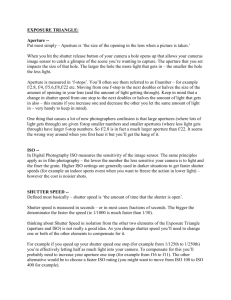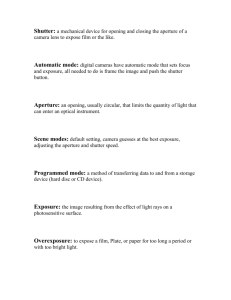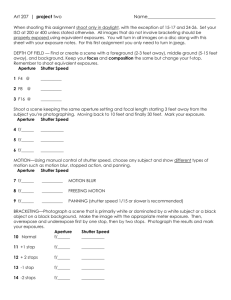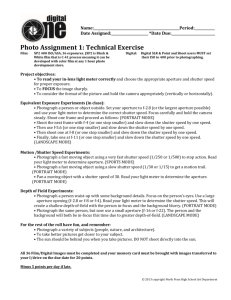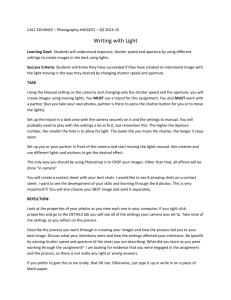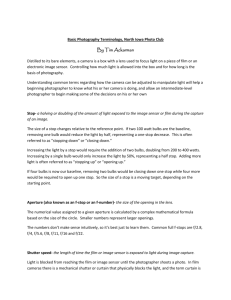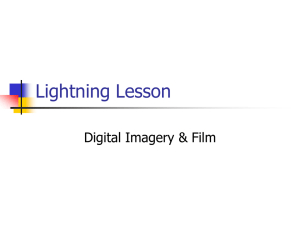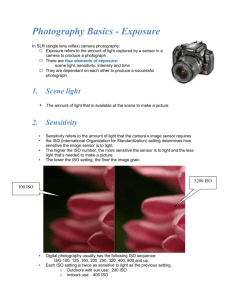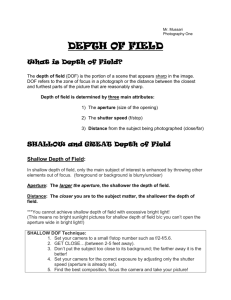Aperture Settings
advertisement
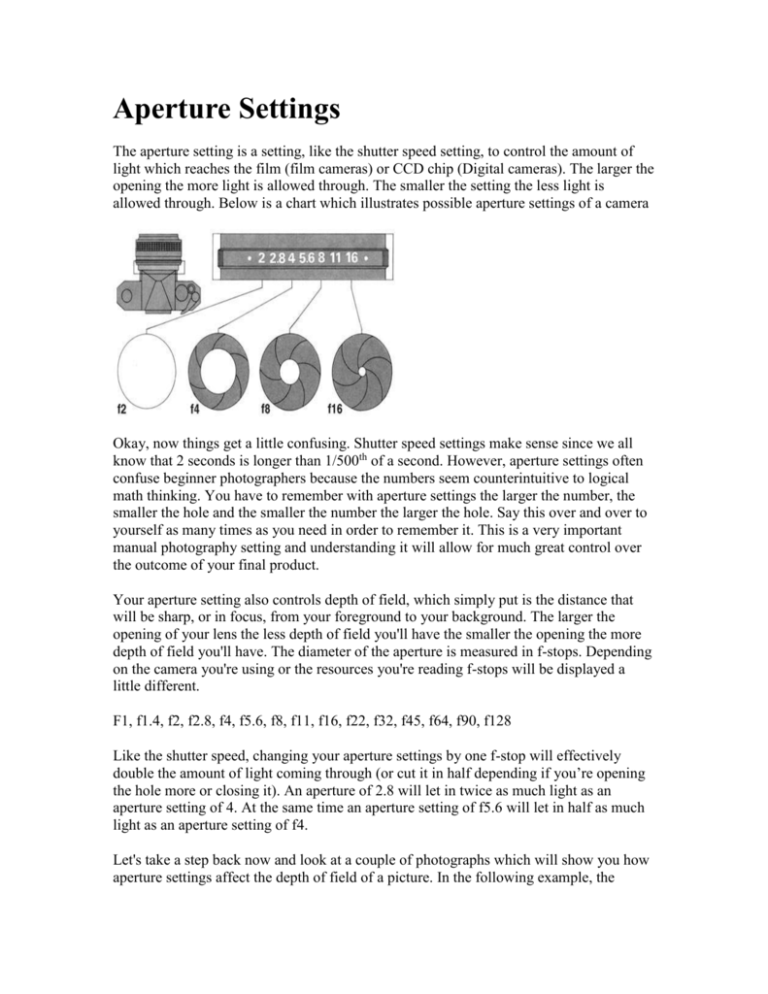
Aperture Settings The aperture setting is a setting, like the shutter speed setting, to control the amount of light which reaches the film (film cameras) or CCD chip (Digital cameras). The larger the opening the more light is allowed through. The smaller the setting the less light is allowed through. Below is a chart which illustrates possible aperture settings of a camera Okay, now things get a little confusing. Shutter speed settings make sense since we all know that 2 seconds is longer than 1/500th of a second. However, aperture settings often confuse beginner photographers because the numbers seem counterintuitive to logical math thinking. You have to remember with aperture settings the larger the number, the smaller the hole and the smaller the number the larger the hole. Say this over and over to yourself as many times as you need in order to remember it. This is a very important manual photography setting and understanding it will allow for much great control over the outcome of your final product. Your aperture setting also controls depth of field, which simply put is the distance that will be sharp, or in focus, from your foreground to your background. The larger the opening of your lens the less depth of field you'll have the smaller the opening the more depth of field you'll have. The diameter of the aperture is measured in f-stops. Depending on the camera you're using or the resources you're reading f-stops will be displayed a little different. F1, f1.4, f2, f2.8, f4, f5.6, f8, f11, f16, f22, f32, f45, f64, f90, f128 Like the shutter speed, changing your aperture settings by one f-stop will effectively double the amount of light coming through (or cut it in half depending if you’re opening the hole more or closing it). An aperture of 2.8 will let in twice as much light as an aperture setting of 4. At the same time an aperture setting of f5.6 will let in half as much light as an aperture setting of f4. Let's take a step back now and look at a couple of photographs which will show you how aperture settings affect the depth of field of a picture. In the following example, the photographer used a shallow depth of field by using a larger aperture opening (small fstop number). The result is a main subject who's in focus but a blurred background. Aperture - Size of Aperture - Depth of Field F2.8 - Nothing is in focus - Very Large F4 - Large - Some things are in focus, in front and behind the subject. F5.6 - Medium - Things are staring to be in focus. F8 - Small - More things are beginning to be in focus. F11 - Smaller - Even more things are in focus. F16 - Very Small - Almost everything is in focus F22 - Smallest - Every thing is in Focus Shutter Speed: Camera Settings Your cameras shutter speed is a measurement of how long your cameras shutter stays open when you're taking a picture. The slower the shutter speed the longer the exposure time. When the exposure is set to 1/125 or simply 125 this means that the shutter will be open for exactly 1/125th of a second. Common shutter speed options are 2, 1, 1/2, 1/4, 1/8, 1/15, 1/30, 1/60, 1/125, 1/250, 1/500, 1/1000, 1/2000 A shutter speed of 2 would therefore keep the shutter open for 2 seconds, while a shutter speed of 1/2000 would keep the shutter open for 1/2000th of a second. It is also important to note that each increase in shutter speed doubles the amount of light coming in. For example, a 2 second shutter speed will let in twice as much light as a 1 second shutter speed. Similarly, a 1/15th shutter speed will let in twice as much light as a 1/30th shutter speed. Shutter speed will have two major effects on your photographs. First off it, like aperture, will control the amount of light allowed into hit the film (or CCD chip if you are using a digital camera). Therefore changing the shutter speed will have an effect on your photographs exposure level. If you keep the shutter speed open for a long time, for example 1 or 2 seconds, your picture will be brighter and possibly too bright (overexposed). If you don't keep your shutter open long enough (for example, 1/2000th of a second) your picture could be too dark (under-exposed). Secondly, your shutter speed will effect movement within your photograph. A photograph is simply a recoding of light. If you open and close your shutter speed very quickly you will freeze a moment in time. Quick shutter speeds are great to freeze fast moving object while slower shutter speeds can lead to some interesting visual effects since they will capture movement within a frame. For example, in the following picture the photographer used a long shutter speed which kept the shutter speed open for a longer period of time before closing. In this example the camera must have been on a tripod which ensured everything that was static (maintained its position) remained in its place. However anything which moved within the photograph left its trails in the photograph for the duration that the shutter was open for. In the example below a car s headlights were traced during the films exposure to a car driving on the following highway. How to Set Your Camera's Exposure Now that you understand the settings of both shutter control and aperture settings you need to know what influence they have on overall exposure. Many of you are probably familiar with overexposed and underexposed pictures. Overexposed pictures are a result of too much light coming through, and underexposed pictures are those which are too dark. Let's say for example, that we used a fast shutter speed (to limit the amount of light coming in) and a high aperture number (small home) to limit the amount of lighting coming in and to capture the greatest detail for a landscape photograph. The following would be the result. Notice how in this photograph the subject is underexposed. There is not enough light shed on the film (or CCD if the camera was digital) to bring out the details of the subject. In the case above it may have been the intention of the photographer to create a darker image and often underexposed images are taken intentionally. Your concern is to ensure you don't take unintentional underexposed images. Now image you set your aperture setting to a low number (larger opening to let in more light) and you set your shutter speed to a longer exposure time. The result would be a photograph which overexposes your photograph. Look at the following example. Therefore it is important to know how shutter speed and aperture work in conjunction with each other to determine the overall exposure levels of a photograph. Think of shutter speed and aperture as a teeter totter. On one side you have aperture and on the other side you have the shutter speed. As the shutter speed gets set to one increment higher the aperture setting needs to get set to one increment lower in order to keep the light coming into the camera the same. And don't forget that every decrease in shutter speed decreases the amount of light by half, and every increment the aperture opens doubles the amount of light coming in. You can therefore use different combinations of aperture settings and shutter speed settings to achieve the exact same exposure levels. Look at the chart below to learn more about how to balance aperture settings with shutter speed settings. Since shutter speed and aperture settings move in equal increments, you can trade shutter stops for aperture stops and have the same exposure. This gives you a range of aperture openings and shutter speeds that you can use ISO Settings in Digital Photography What is ISO? In traditional (film) photography ISO (or ASA) was the indication of how sensitive a film was to light. It was measured in numbers (you’ve probably seen them on films - 100, 200, 400, 800 etc). The lower the number the lower the sensitivity of the film and the finer the grain in the shots you’re taking. In Digital Photography ISO measures the sensitivity of the image sensor. The same principles apply as in film photography - the lower the number the less sensitive your camera is to light and the finer the grain. Higher ISO settings are generally used in darker situations to get faster shutter speeds (for example: an indoor sports event when you want to freeze the action in lower light) - however the cost is noisier shots. I’ll illustrate this below with two enlargements of shots that I just took - the one on the left is taken at 100 ISO and the one of the right at 3200 ISO (click to enlarge to see the full effect). 100 ISO 3200 ISO 100 ISO is generally accepted as ‘normal’ and will give you lovely crisp shots (little noise/grain). Most people tend to keep their digital cameras in ‘Auto Mode’ where the camera selects the appropriate ISO setting depending upon the conditions you’re shooting in (it will try to keep it as low as possible) but most cameras also give you the opportunity to select your own ISO also. When you do override your camera and choose a specific ISO you’ll notice that it impacts the aperture and shutter speed needed for a well exposed shot. For example - if you bumped your ISO up from 100 to 400 you’ll notice that you can shoot at higher shutter speeds and/or smaller apertures. When choosing the ISO setting I generally ask myself the following four questions: 1. 2. 3. 4. Light - Is the subject well lit? Grain - Do I want a grainy shot or one without noise? Tripod - Am I use a tripod? Moving Subject - Is my subject moving or stationary? If there is plenty of light, I want little grain, I’m using a tripod and my subject is stationary I will generally use a pretty low ISO rating. However if it’s dark, I purposely want grain, I don’t have a tripod and/or my subject is moving I might consider increasing the ISO as it will enable me to shoot with a faster shutter speed and still expose the shot well. Of course the trade off of this increase in ISO will be noisier shots. Situations where you might need to push ISO to higher settings include: Indoor Sports Events - where your subject is moving fast yet you may have limited light available. Concerts - also low in light and often ‘no-flash’ zones Art Galleries, Churches etc- many galleries have rules against using a flash and, of course being indoors, are not well lit. Birthday Parties - blowing out the candles in a dark room can give you a nice moody shot which would be ruined by a bright flash. Increasing the ISO can help capture the scene. ISO is an important aspect of digital photography to have an understanding of if you want to gain more control of your digital camera. Experiment with different settings and how they impact your images.
